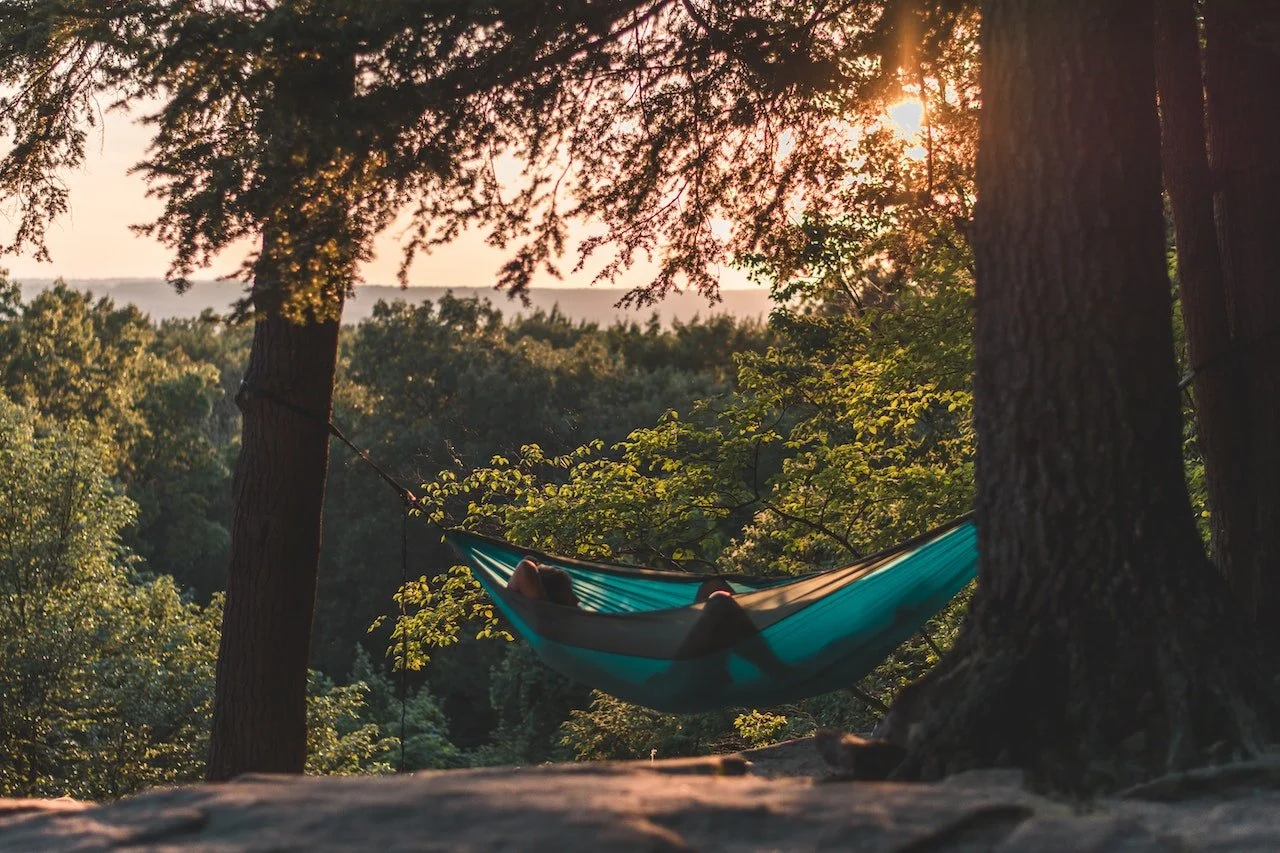Here is How to Hang your Hammock Easily (With Steps)
One of the best feelings in the world is lying down in a comfortable place to rest after a long day. This is especially true when your day includes lots of outdoor activities, intense hikes, and fun adventures.
When camping or simply enjoying outdoor experiences, a hammock can provide the perfect relaxing hide-out. They are easy to hang, cause minimal environmental impact, and protect your sleep from being disturbed by bugs or other animals.
You might think hanging a hammock up is a challenging task, but most hammocks provide instructions and all the tools you need. Still, if you are worried about how to do it properly, we have developed this step-by-step guide on how to hang your hammock easily.
Photo credit: Dziana Hasanbekava
How to choose the best place to hang your hammock
Picking the location to hang your hammock is the first step. When camping, the Leave No Trace principle should guide your decision. Avoid causing any impact on the vegetation around your camping place, and make sure you’ll be safe — both when setting it up and when sleeping in it.
For most hammocks, 3 metres between hanging points is the perfect distance. The height of the hammock is also an important consideration. You should be able to hang the hammock at a height of at least 1.7 metres.
Take privacy into consideration as well. If you are camping, you might find other people in the same spot and might need to choose a location for your hammock that will allow you to sleep peacefully.
As for safety, it is recommended that you don’t set up camp — or hammocks — near rivers, as flash floods could take you by surprise. Lone trees can also be a hazard, as they are more likely to be hit by lightning during a storm. Avoid hanging hammocks above rocks, so you won’t injure yourself in case of a fall.
Choosing the right trees is crucial. You need enough space between the trees to comfortably lie between them with enough tension to ensure the hammock will stay above ground. Pay attention to the trees. Look for a thick, sturdy trunk and healthy branches.
If you believe finding proper trees — separated by the perfect distance and strong enough to hold your body weight — will be too difficult, you can plan ahead and bring a hammock stand with you.
The gear you’ll need to hang your hammock
A hammock stand is always helpful, but there are other pieces of equipment that will help you set up your hammock, so you have a comfortable place to rest during your camping trip or leisure time.
Choosing a hammock
The most important item is the hammock itself. There are plenty of materials to choose from, and you can make your decision based on comfort, warmth, durability, and flexibility. There are hammocks that are perfect for just one person and hammocks that are great for sharing. Choose one that best fits your purpose.
The way you’ll transport your hammock and camping gear — as well as for how long — is also a significant aspect to consider. Some materials are lighter than others, making them easier to carry.
Hammock straps
The second most important item on your camping checklist is hammock straps. Some hammocks come with straps, but sometimes it might be necessary to buy them separately. If that’s the case, make sure the hammock straps you buy are compatible with your hammock.
The straps will make it easier for you to hang your hammock as well as protect trees from damage.
Getting longer straps will help if the trees are too far apart. They can also be very useful if tree trunks are extra chunky. It is imperative to consider how much weight the straps can support and the quality of the equipment. The top brands will last longer and be able to hold more weight.
Carabiners
Most hammocks will come with carabiners to help you hang the hammock on straps, poles, or trees, but it can be handy to have some extras available for additional safety.
Hammock rope or chain
A rope is an important item when camping. For hammock hanging, the rope will allow you to tie your hammock around trees or poles, extend the length of your hammock if trees are too far apart, or just offer extra safety and support.
Make sure you use the correct knots when tying your hammock with rope, tying one end to the hammock and the other to the pole or tree you’ll be using.
Chains can be used for the same purpose. They don’t require knots but might need hooks. If chains are your preferred method, make sure they are safely placed on straps and aren’t so loose that they can move around the pole or tree trunk.
Hammock hooks
Hooks usually come in a hanging set designed to fit your hammock perfectly. They are great for putting up hammocks at home, in fixed settings. Carabiners are a safer option outdoors as they provide more stability.
Hammock stands
Stands are perfect for installing your hammock in your garden or on your porch. They are easy to assemble and allow your hammock to be free-standing.
For camping, some hammock stands can be easy to assemble and lightweight.
How to properly hang a hammock
Photo credit: Uriel Mont
With all the equipment ready, it’s time to hang the hammock.
Here we will provide instructions for hanging the hammock from different structures, depending on your needs. Follow these easy steps to prepare your perfect resting cocoon:
How far off the ground should you hang a hammock?
Your hammock shouldn’t hang too high off the ground or too low. If you put it up too high, it will be difficult to get in or out. If it’s too low, your back could hit the ground when you are lying in the hammock.
It is recommended that, once hung, the lowest part of the hammock should be betwen 50 to 60 cm off the ground. 60 cm works best if you plan to use the hammock in the same spot for more than a couple of days, as the material will eventually sag with use.
The best height to have your hammock, however, depends on both your height and your personal preference. Some people prefer to place their hammocks at higher up while others would rather be closer to the ground. Take safety precautions into consideration and install your hammock according to your preferences.
How to hang a hammock from a tree
The first step is to attach your hammock straps around the trees.
Loop one end of the strap around the tree and secure it by passing the other end through the loop.
The straps should be at eye level so that when you sit in the hammock, your body is suspended, but your feet can still touch the ground.
Hang the hammock to the straps by clipping one carabiner to each strap and using a hook to attach the hammock to the strap.
Make sure the height of the hammock is right and that the ends are far apart enough so it will remain above ground once you get in.
How to hang a hammock from a porch or a pole
Hanging a hammock from a porch is similar to hanging it from a tree.
Loop the straps or a piece of rope around the pole you have selected as an anchor point.
You can either attach the hammock directly to the rope or use carabiners or hooks if necessary. This will make your hammock extra secure around the pole.
For porches, make sure the columns are strong enough to support your body weight.
How to hang a hammock from a car
Hanging a hammock from a car can be a very useful solution during camping trips. Taking a hammock with you is more comfortable than sleeping in the car and, with the right equipment, it can be very easy to set-up.
First, park your car close to a tree, pole or post you can use as a second anchor point. If you’re travelling with other people, you can use two cars and hang a hammock between them.
If you car has a roof rack, you can use hammock straps to tie the hammock to the rack and then to another anchor point.
If you don’t have a roof rack it is still possible to hang your hammock from your car. First, open the front and the back door of one side of your car and tie the strap to the pillar between the doors as your anchor point.
Once the strap is secure, close the doors and use a carabiner to attach the hammock to the strap.
How to hang a hammock using stands
If you want to be prepared for every possible situation and don’t want to be caught off guard during your camping trip, taking a hammock stand with you is a great option. Stands are light-weight, easy to assemble, and provide the perfect structure for you to hang your hammock at just the right height.
When using a hammock stand, first follow the instructions to assemble your stand. The manufacturer should provide a step-by-step guide for you to put the stand up securely and have it ready for your hammock. If not, you can find instructions online by searching the brand name.
Once the structure is ready, hang the ends of your hammock from the proper poles on each side of the stand. You might need hooks, or you may be able to simply insert the ends of your hammock into the top of the stand.
Tips for hanging a hammock for the first time
Photo credit: Max Andrey
Hanging a hammock is easy to do, and it will get even easier the more you practise it.
If this is your first time putting up a hammock, here are some tips for you to have the most relaxing experience possible:
1. Make sure you’ll lie comfortably on the hammock once it is up
Once your hammock is up, it should have a “smiley face” appearance, with the lowest hanging part remaining above the ground. As we covered previously, the hammock will ideally hang at a height of at least 50 cm off the ground once it is up. This means that you’ll be in a comfortable position when you lie in it.
Lying at an angle is also advisable, as the hammock is structured to stay higher the more surface area you cover with your body. If you curl up too much, your back will be closer to the ground.
2. Use a bug net
An accessory that might be a good idea to bring with you on your camping trip is a bug net. When camping outdoors, bugs can disturb your sleep and cause problems. Nets designed specifically for hammocks can greatly improve your sleep.
3. Take extra quilts with you
Hammocks can be extremely comfortable but not always warm. Make sure you have extra layers on if you are sleeping outside, and carry quilts to protect you from the wind and the cold.
Final thoughts
Now you know what to expect, you are ready to have a great — and restful — camping or outdoor experience! Sleeping or lying in a hammock while you’re outdoors is a great way to reconnect with mother nature instead of simply sleeping in a tent. Although this isn’t for everyone, we highly recommend trying it out at least once in your life before dismissing it — it really is an amazing experience to be able to fall asleep with the stars directly above you.




